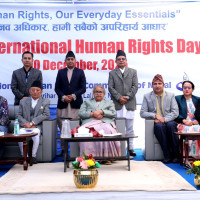- Wednesday, 10 December 2025
Nepal finalises elephant conservation action plan
Kathmandu, June 26: In the past 23 years, at least 350 people have been killed by elephants, while 57 elephants have died as a result of human intervention over the last 15 years.
This conflict has been increasing in recent years, mainly due to unmanaged human settlements along wild elephant corridors, particularly in the Chure range, which serves as a key migration route between India and Nepal.
Ashok Ram, who holds a PhD in elephant research and works as Chief Conservation Officer at Bardiya National Park, warned that the situation of wild elephants is critical, with the main breeding males often being targeted and killed. “If we fail to protect the breeders, there will be no wild elephants left in the next 50 years,” he said.
In response to this alarming situation, Nepal has finalised the Elephant Conservation Action Plan 2025-2035, aimed at securing a viable wild elephant population while balancing conservation needs with development priorities.
The main aim of the Action Plan is to protect elephant habitats, reduce human-elephant conflict and promote peaceful coexistence between people and elephants. The Action Plan also focuses on enhancing research and monitoring, tackling poaching and illegal trade and strengthening partnerships at local, national, and international levels, said Bed Kumar Khadka, Spokesperson and Deputy Director General at the Department of National Parks and Wildlife Conservation.
The Asian elephant, scientifically called Elephas maximus, the largest land mammal in Asia, is listed as Endangered on the IUCN Red List. With fewer than 50,000 remaining in the wild across 13 countries, these animals face major threats, including habitat loss, fragmentation, human-wildlife conflict, and poaching.
Nepal is home to two subpopulations of wild elephants, in the east from Jhapa to Chitwan, and in the west from Kapilvastu to Kanchanpur. Around 230 wild elephants roam the country’s forests, while about 180 elephants remain in captivity, some managed by the government and others privately owned. Around 150 wild elephants regularly move between Nepal and India.
However, according to the Action Plan, suitable elephant habitat in Nepal has been steadily shrinking, with an annual loss rate of 0.27 per cent recorded between 1930 and 2020, a trend that continues till date. Much of the remaining elephant habitat lies outside protected areas, making the species vulnerable to habitat destruction, unplanned infrastructure, and conflict with humans, Khadka said.
Most wild elephants use the migration route through the Chure range, which has become increasingly populated in recent years, leading to more frequent conflicts due to unmanaged settlements.
Khadka said that the 10-year Action Plan has been developed through extensive consultations with experts, government agencies, conservation organisations and local communities, at a time when conflicts between wild elephants and humans are increasing outside protected areas.
The Action Plan sets various targets to mitigate human-elephant conflict, including protecting existing elephant habitats and critical forest corridors to ensure safe movement for elephants, enhancing capacity for monitoring and research using modern technologies, controlling poaching and illegal wildlife trade, and improving the management and welfare of captive elephants in the country.
For the 10-year plan, an estimated budget of Rs. 4.58 billion has been proposed with a mid-term review scheduled after six years to assess progress and suggest improvements.
According to Khadka, the country has made outstanding progress in elephant conservation in recent years, expanding protected areas such as Banke, Bardiya, Chitwan and Shuklaphanta National Parks, where elephants find refuge.
However, over half of suitable elephant habitats still lie outside protected zones, making elephants vulnerable to habitat fragmentation, human settlement, and unplanned infrastructure like highways and irrigation canals.
“The elephants do not harm people unless they feel threatened. Most incidents involve people who chase them away or those under the influence of alcohol,” he said. Wild elephants also use traditional routes when travelling, and when these routes are encroached upon, they often damage settlements and harm people.
“Through this Action Plan, we are also planning to raise awareness among local communities about the threats and behaviour of wild elephants,” he added.
According to Ram, if the government implements the Action Plan properly within the said period, the human-elephant conflicts could be minimised and the most valuable species on earth could be protected.
This is Nepal’s second Elephant Conservation Action Plan. The first was drafted in December 2009 and covered the period from 2009 to 2018.







-square-thumb.jpg)








